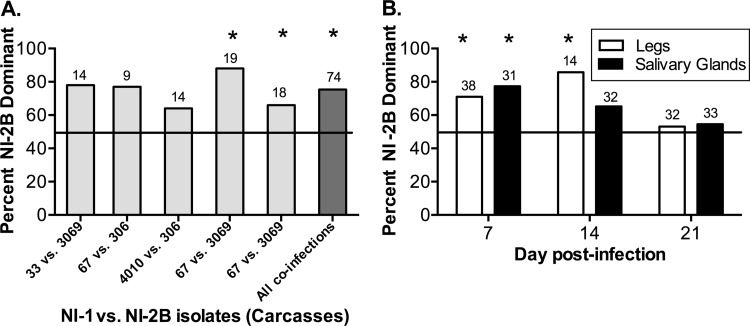FIG 6.
Proportion of mosquitoes with the dominant NI-2B clade during coinfection. The number of mosquitoes in which NI-2B virus was found to be more abundant than NI-1 virus, defined as greater than 50% NI-2B isolates in a given mosquito, was tallied and reported as a percentage of the total number of infected mosquitoes in each group. (A) The percentage of mosquitoes in which the NI-2B clade was dominant (i.e., more NI-2B viruses than NI-1 viruses) in day 7 carcasses in five coinfection experiments (virus pairs listed on the x axis) is shown in light gray, with the number of mosquitoes indicated above each bar; the last bar represents the sum tally for all five coinfections. A two-sided exact binomial test was used to determine significance, using a hypothetical probability of success of 0.5 (i.e., assuming that both clades have equivalent replicative fitness). The P values (with significant values indicated in bold below and with an asterisk in the figure) and numbers of mosquitoes assayed for each infection are as follows: for NI-1/NI-2B, for isolate 33 versus isolate 3069, P = 0.057 (n = 14); for isolate 67 versus isolate 306, P = 0.180 (n = 9); for isolate 4010 versus isolate 306, P = 0.424 (n = 14); for isolate 67 versus isolate 3069, P < 0.001 (n = 19); for isolate 67 versus isolate 3069, P= 0.031 (n = 18); for all coinfections, P < 0.001 (n = 74). (B) Percentage of mosquitoes in which clade NI-2B was dominant in legs and salivary glands. Samples from all coinfection assays, collected on the day indicated below, were tallied together and are presented as a function of time (day 7, day 14, and day 21). Significance was determined as described above for panel A. The P values (with significant values indicated in bold below and with an asterisk in the figure) and numbers of tissues assayed for each infection are as follows: for legs, day 7, P = 0.014 (n = 38); day 14, P = 0.013 (n = 14); and day 21, P = 0.860 (n = 32); for salivary glands, day 7, P = 0.003 (n = 31); day 14, P = 0.600 (n = 32); and day 21, P = 0.729 (n = 33).

